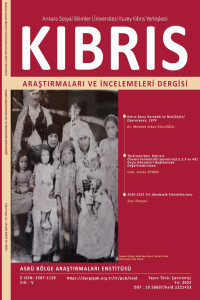İlk Okuma-Yazma Öğretimi Dersinde Teknoloji Kullanımına İlişkin Sınıf Öğretmeni Adayı Öğrenci Görüşlerinin Değerlendirilmesi
İlk okuma- yazma öğretimi, sınıf öğretmeni, oyunlaştırarak öğrenme, teknolojiye dayalı öğrenme, eğitimde materyal
Evaluation of Student Teachers' Views on the Use of Technology in the First Literacy Teaching Class
___
- Alpert, R. ve Haber, R. N. (1960). Anxiety in academic achievement situations. The Journal of Abnormal and Social Psychology, 61(2), 207-15. doi:10.1037/h0045464.
- Ashman, A. F. ve Conway, R. N. F. (1993). Using cognitive methods in the classroom. London: Routledge.
- Aslan, C. (2010). Düşünme becerilerini geliştirici dil ve edebiyat öğretimi ortamları – Bir eğitim durumu örneği-, Balıkesir Üniversitesi Sosyal Bilimler Enstitüsü Dergisi, 24(13), 127-152.
- Aşılıoğlu, B. ve Özkan, E. (2013). Ortaokul öğrencilerinin yazma kaygılarının bazı değişkenler açısından incelenmesi: Diyarbakır örneği. International Journal of Social Science, 6(6), 83-111. doi: 10.9761/JASSS1527.
- Bank, C. G. (2006). Reading and writing taught in a sophomore course on plate tectonics. Journal of Geoscience Education, 54(1), 25-30.
- Bartscher, M. A., Lawler, K. E., Ramirez, A. J. ve Schinault, K. S. (2001). Improving student’s writing ability through journals and creative writing exercises (Yayımlanmamış yüksek lisans tezi). Saint Xavier University, Chicago, IL.
- Baştuğ, M. (2015). İlkokul 4. sınıf öğrencilerinin yazma eğilimi, tutumu ve yazma tutukluğunun yazma başarısı üzerindeki etkisi. Eğitim ve Bilim, 40(180), 73-88.
- Bishop, W. ve Ostrom, H. A. (1994). Colors of a different horse: Rethinking creative writing theory and pedagogy. Urbana, Ill: National Council of Teachers of English.
- Bloom, L. Z. (1981). Why graduate students can’t write: Implications of research on writing anxiety for graduate education. Journal of Advanced Composition, 2(1-2), 103-117. Brand, A. G. ve Leckie, P. A. (1988). The emotions of professional writers. The Journal of Psychology, 122(5), 421-439.
- Bridge, C. A., Compton-Hall, M. ve Cantrell, S. C. (1997). Classroom writing practices revisited: The effects of statewide reform on writing instruction. Elementary School Journal, 98(2), 151-170.
- Calkins, L. M. (1994). The art of teaching writing (2. basım). Portsmouth, NH: Heinemann.
- Cheshire, B. W. (1984, 29-31 Mart). The effects of writing apprehension on writing quality. ERIC Veritabanı http://eric.ed.gov/?id=ED216387 adresinden erişildi.
- Claypool, S. H. (1980). Teacher writing apprehension: Does it affect writing assignments across the curriculum. ERIC Veritabanı http://eric.ed.gov/?id=ED258264 adresinden erişildi.
- Clark, C. ve Dugdale, J. (2011). Young people's reading and writing: An in-depth study focusing on enjoyment, behaviour, attitudes and attainment. ERIC Veritabanı http://eric.ed.gov/?id=ED521656 adresinden erişildi.
- Combs, M. (1996). Developing competent readers and writers in the primary grades. New Jersey: Prentice-Hall.
- Conheim, W. W. ve Page, L. (2003). Personal journals: New users for an age-old practice. Information Today, 20(1), 27-30.
- Coşkun, E. (2009). Yazma eğitimi. Ahmet Kırkkılıç ve Hayati Akyol (Ed.). İlköğretimde Türkçe öğretimi. Ankara: Pegem Akademi Yayıncılık.
- Cunningham, P. M. ve Allington, R. L. (2003). Classrooms that work: They can all read and write (3. basım). Boston: Allyn and Bacon.
- Yayın Aralığı: Yılda 2 Sayı
- Başlangıç: 2016
- Yayıncı: Ankara Sosyal Bilimler Üniversitesi
Kıbrıslı Rumlar ve Annan Planı
Tarih Boyunca Yabancıların Kaleminden Lefke Kasabası
Edebiyat Coğrafyası Bağlamında Harid Fedai'nin "Lefke Sayıklamaları Destanı" Üzerine
Doğu Akdeniz Enerji Kaynaklarına Ekonomi-Politik Bir Yaklaşım
Deniz İSTİKBAL, Haci Mehmet BOYRAZ
Kıbrıs’ta Sömürge Yönetimi ve Osmanlı Vatandaşı Olarak Kıbrıslı Türkler
